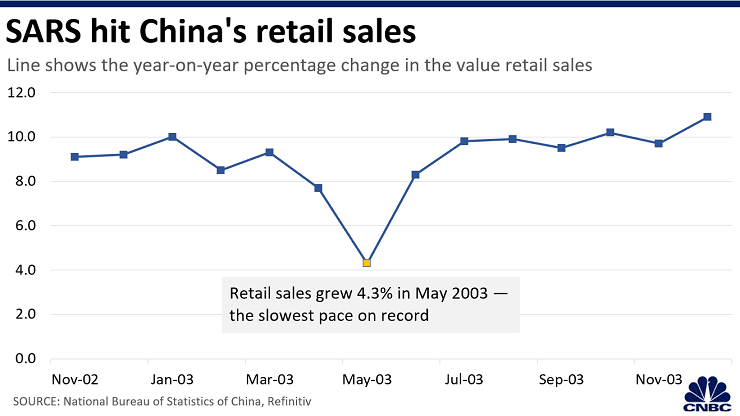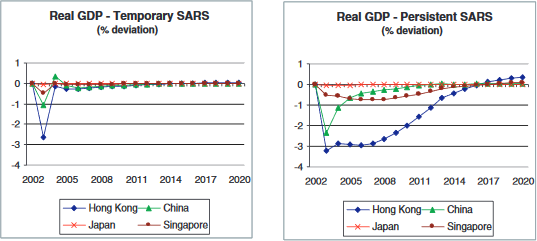We regret not going hunting for these low-hanging apples on sons’ heads months earlier, but we Will Tell you what we have found now, and apologise for the delay. Most of these sources are from before even 2019 so it’s not like they were recently-made-up-bullshit-for-The-Economy-Must-Grow but they really do paint the picture we’ve been sketching with our blood, that (as you all already know) it is no dichotomy between HEALTH and ECONOMY but they are one and the same thing.
Let us begin by going back over the recents.
2020-02-10: CNBC: West Taiwan Did It Right The First Time And They Do It Again
https://www.cnbc.com/2020/02/11/coronavirus-4-charts-show-how-sars-hit-chinas-economy-in-2003.html
If you wanted to see ‘V’-shaped recovery, you would have Done What West Taiwan Did.

Economists from French bank Societe Generale said they expect the coronavirus “to be brought under control” in the later part of the first quarter, which would allow industrial firms to “raise capacities to meet orders.” But the economists warned that the situation in China may not improve as they expect. They didn’t reckon with the rest of the world fucking everything up but hey.
2020-02-03: NYTimes: Fear Is Healthy And Fear Is Good, Fear Keeps Factories Clean And Lets Them Reopen Early
https://www.nytimes.com/2020/02/03/business/economy/SARS-coronavirus-economic-impact-china.html
In a bid to keep people home and halt the spread of the virus, the government extended the holiday through Sunday, adding three days. But the fear of the virus is so widespread and intense that many workers are likely to remain away from factory towns this week.
“We may still be in the early stages,” of the coronavirus crisis, Judith McKenna, who runs Walmart’s International business, wrote in an internal memo on Friday.
China is the world’s largest manufacturer of toys. At the International Toy Fair in Nuremberg, Germany, many Chinese suppliers expressed confidence that their factories would soon reopen, said Rick Woldenberg, chief executive of Learning Resources, a family-owned manufacturer of educational products and toys in Illinois.
“But no one’s quite sure how much of this information can be relied upon,” Mr. Woldenberg said. “If this goes on for four more months, we are talking about a big problem,” said Jim Silver, chief executive of TTPM.com, a consumer research site.
It went on all right, but in that time we discovered just which information was not to be relied upon.
—
Time to go back further, because this really should have been no surprise. It was no surprise.
2018-06-28: “Scientists”: Actually, surprise! Social and economic impacts are not as serious, when responses are more effective! Surprise!
In a study of “Impacts on Health, Society, and Economy of SARS and H7N9 Outbreaks in China”, scientists claim (that’s right, claim — what is claim but fake news) that
. Of course, it is a largely qualitative, and rather subjective study, so who gives a shit, right?
2008: UK Public Health: Official Modelling And Media Alarmism Significantly Overestimate Negative Economic Impacts
https://www.ncbi.nlm.nih.gov/pmc/articles/PMC7114672/pdf/main.pdf
losses correspond only to the relatively short period of the disease outbreak, after which consumer confidence returned and many stocks that had diminished were replenished and some purchases which were forgone at the height of the outbreak were made after the perceived risk was reduced. This conjecture is supported by the rapid return to normality (bounce-back)
They also reflect upon the possible role of the media in exacerbating or dampening the impact of SARS upon economic activity. It has been concluded elsewhere that “the general consensus is that the media coverage of SARS was excessive, sometimes inaccurate, and sensationalist” . Unfortunately they seem to realise some basics of social psychology, including wildly distorting optimism biases, that lead to, well, we’ve seen it.
2004: National Acadamies: Possible Future Outbreaks Actually Increase Costs (If Correctly Estimated)
https://www.ncbi.nlm.nih.gov/books/NBK92462/pdf/Bookshelf_NBK92462.pdf
Paradoxically, workshop participants discussed the global cost of SARS associated with lost economic activity — now estimated to have been around $40 billion, and possibly as high as $54 billion if investors remain cautious about the possibility of future outbreaks — as a potential cost of neglecting to invest in public health infrastructure. Several participants warned of a vicious spiral to be avoided: an economic downturn resulting from SARS or another pandemic which squeezes funding for public health, further weakening the world’s ability to pre-vent or contain subsequent outbreaks. The message here: an ounce of prevention is worth a pound of cure.

officials in any nation or region of the world would likely face a similar dilemma in attempting to consider its obligations to protect the public’s health while at the same time considering how to maintain equally important aspects of social stability and economic development
2003: Who whould whant tho lhisten tho the WHO anywhay¿
https://www.who.int/whr/2003/en/Chapter5-en.pdf?ua=1
Ironically, this chapter is titled “SARS: lessons from a new disease”. Perhaps not ironically, because remember how in places like Australia, students are 3.5 years behind their equivalents in West Taiwan, but the authorities still use the potential retardation from online learning as a justification for insisting that students turn up physically and spread disease at school. So much for learning any lessons.
The willingness of governments in the Western Pacific Region to put public health considerations ahead of economic concerns about the impact of SARS was crucial to the success of the collaborative effort.
The first and most compelling lesson concerns the need to report, promptly and openly, cases of any disease with the potential for international spread. Attempts to conceal cases of an infectious disease, for fear of social and economic consequences, must be recognized as a short-term stop-gap measure that carries a very high price: the potential for high levels of human suffering and death, loss of credibility in the eyes of the international community, escalating negative domestic economic impact, damage to the health and economies of neighbouring countries, and a very real risk that outbreaks within the country’s own territory will spiral out of control.
2003: Finally, A True Australian Perspective, From Our Liberal Treasury No Less
https://treasury.gov.au/sites/default/files/2019-03/Economic-Roundup-2003.pdf
SARS represents a crisis of confidence and a demand shock that hit East Asia, especially China, hard. Fear of contracting SARS influenced the behaviour of individuals, making them avoid public places, travel and face to face contact. As the outbreak appears to be coming under control, the worst of the economic decline in East Asia should be largely limited to the June quarter. Anecdotal evidence suggests that economic activity and behaviour is gradually returning to normal in East Asia. This suggests that the SARS-induced economic shock to East Asia should be relatively short-lived, and the overall impact on world economic growth should be relatively small.
The recent outbreak of SARS will have a mild and temporary impact on the Australian economy and possibly reduced business confidence. The limited impact of the SARS epidemic on the Australian economy will nevertheless be predicated on the continued containment of the virus and no substantial outbreak of SARS in Australia; however, this latter risk appears to be diminishing.
The long term economic impact of SARS will depend largely on whether governments can quickly implement effective public health policies. This will require increased investment in public health and will have implications in terms of increased fiscal outlays.